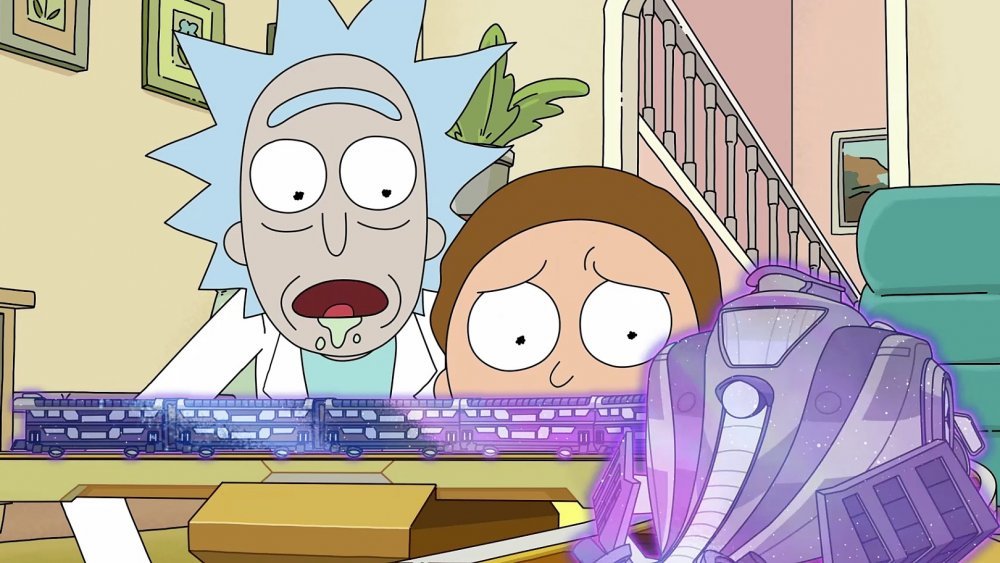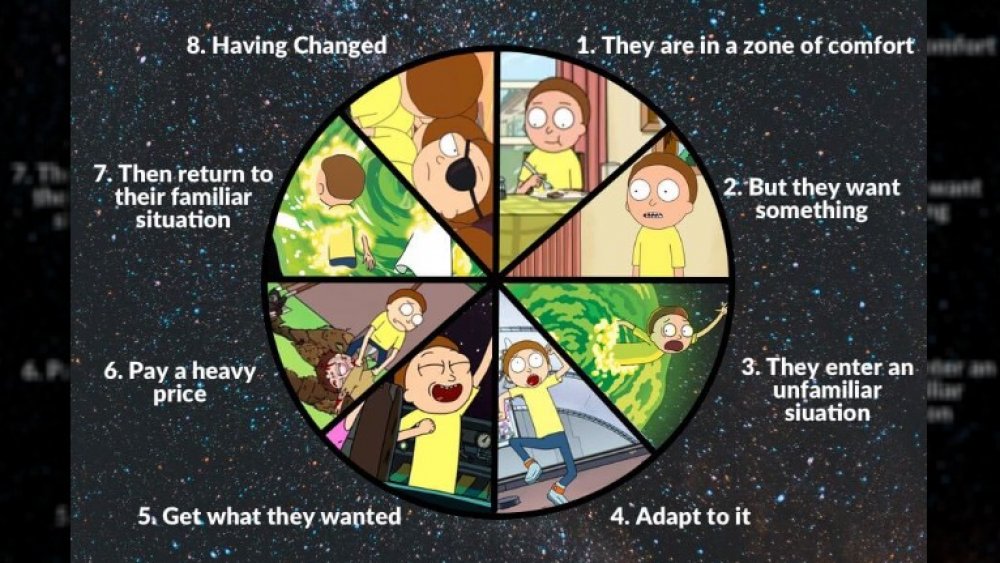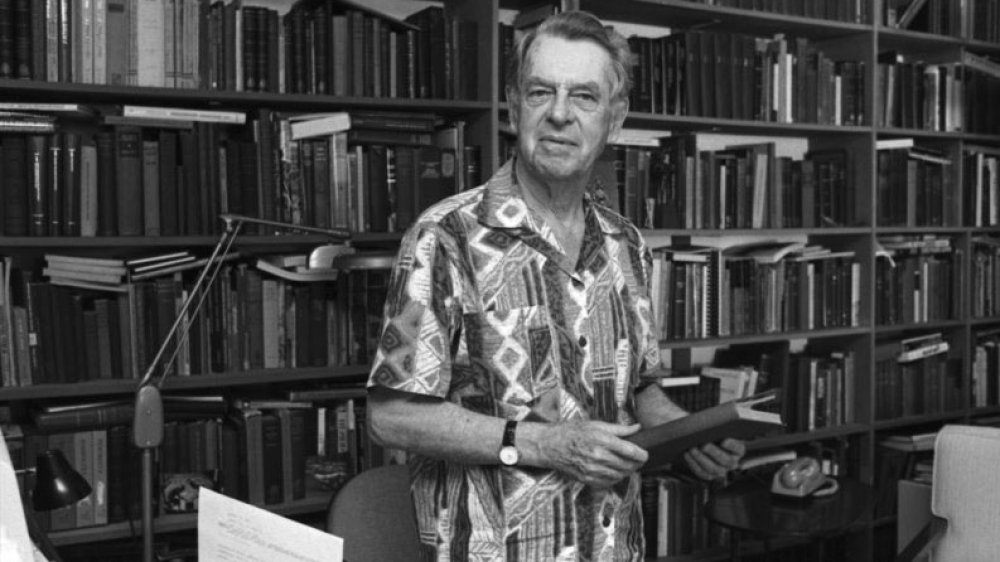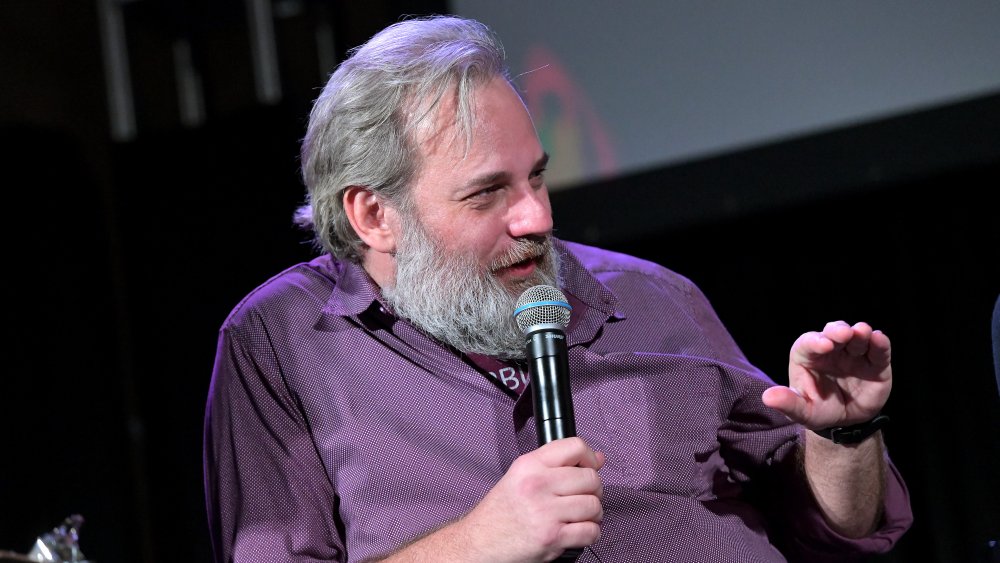The Truth About The Rick And Morty Story Circle
Rick and Morty co-creator Dan Harmon sure knows how to tell a mean story, and a fourth-season episode of his animated sci-fi odyssey may just have given us a look under the hood at his process.
The first Rick and Morty episode back from mid-season hiatus, entitled "Never Ricking Morty," was a disjointed anthology episode framed by a journey through the "Story Train," a literal storytelling vehicle. The Story Train is revealed to be a piece of Citadel merchandise that spawns rapid-fire vignettes loosely bound by esoteric references and — somehow — a little social commentary on commercialism in the time of pandemic. The episode was also a bit of a meta-sendup of Harmon's reported story structure dogma.
According to multiple sources, including a 2018 breakdown on ReedsyBlog, Harmon is a committed writing structuralist to the extent that he has developed his own deconstruction of the story form, which he adapted from Joseph Campbell's famous Monomyth. If that all sounds like gibberish to you, buckle up for a wild ride into the mechanical mind of a genius creator. You'll never watch another episode of Rick and Morty the same way again.
Dan Harmon's Story Circle is Rick and Morty's secret sauce
Rick and Morty has achieved one of the most devoted fan bases on television. Harmon's Community had a similar cult following, if on a somewhat smaller scale. As it turns out, his secret weapon for capturing the zeitgeist is a trademark story structure known interchangeably as "The Embryo," "The Dan Harmon Story Circle," and "The Story Circle." It's an approach that has allowed Harmon to dissect his own stories and reassemble them into coherent, satisfying patterns. This approach has been so successful for Harmon, that it's started to leak out and infect other writers' processes.
Here are the basics: Harmon divides every story he tells into eight general story beats that can be filled with all manner of character moments and plot MacGuffins. Since the character traversing these beats ends up approximately where they started, Harmon arranges them visually in a circle. You actually got a sneak peak at the Story Circle diagram on "Never Ricking Morty" — it perfectly mirrors the train schematics that Rick unfurls after the police academy vignette. As Rick walks Morty through his plan to reach the engine room of the Story Train, he's actually walking him through the circular progress of the plot. The eight beats of the Dan Harmon Story Circle are as follows:
1. A character is in a zone of comfort
2. But they want something
3. They enter an unfamiliar situation
4. Adapt to it
5. Get what they wanted
6. Pay a heavy price for it
7. Then return to their familiar situation
8. Having changed
Basically, any Dan Harmon plot can be boiled down to a story of character growth.
The Story Circle owes a creative debt to Joseph Campbell
Joseph Campbell's landmark concept of the Monomyth was reportedly the inspiration for the development of the Story Circle. Campbell's structure, often referred to as "The Hero's Journey," outlines 11 story beats that can be used to deconstruct epic tales common across numerous cultures. Here are the 11 story beats of the Hero's Journey — note the similarities and differences compared to Harmon's formula.
1. The hero lives in an ordinary world
2. He is called to adventure
3. He refuses the call
4. He meets a mentor
5. He crosses the threshold into an unusual world
6. He is tested, finds allies, fights enemies
7. He descends into the depths of the deepest cave
8. He overcomes an ordeal
9. He seizes the sword, embracing his destiny
10. He travels back across the threshold
11. He is resurrected into a new world transformed by his odyssey
The Monomyth is surprisingly effective at describing the inner workings of texts as varied as Star Wars, The Lord of the Rings, The Once and Future King, and even the Bible. For Harmon's purposes, however, it falls short of offering the kind of character-driven narrative thrust that he finds most effective on TV. The Story Circle serves a similar function as the Monomyth, but it shifts the focus from plot to character.
It should be noted that Campbell was a scholar as opposed to a writer. The purpose of the Monomyth was always descriptive, whereas Harmon's Story Circle clearly serves a generative function in his process.
Can the Story Circle apply to any story?
According to Harmon, the Story Circle can be applied across media and genre, to all of your favorite films, books, and even songs. Fairy tales, memoirs, party jokes, pop songs, 20-minute prog rock epics — they all fit into the Story Circle, as far as Harmon is concerned. You can try it at home if you don't believe him. Diagramming your favorite blockbuster film isn't the worst way to burn an evening.
Harmon has a tendency to get pretty philosophical when discussing the circular arrangement of his storytelling strategy. In a 2018 video essay explaining the Story Circle, he says, "Behind and beneath your culture-creating forebrain, there is an older, simpler monkey brain with a lot less to say and a much louder voice. One of the few things it's telling you, over and over again, is that you need to go search, find, take, and return with change. Why? Because that is how the human animal has kept from going extinct. It's how human societies keep from collapsing, and how you keep from walking into McDonald's with a machine gun."
Basically, Harmon believes that storytelling is as essential to our humanity as our other biological rhythms. The need to share stories is as essential a cycle as breathing or eating. It makes a kind of poetic sense.
The next time you're sitting down for a new episode of Rick and Morty, remember that you're destined to end up right back where you started — albeit having learned something.



